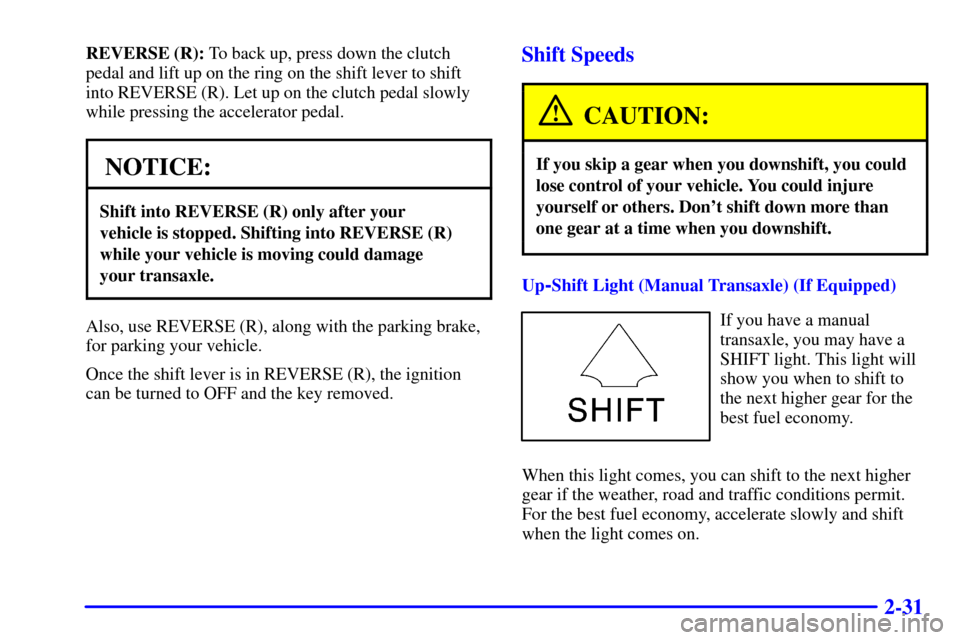Page 79 of 343
2-17 Trunk Release Handle
NOTICE:
The trunk release handle was not designed to be
used to tie down the trunk lid or as an anchor
point when securing items in the trunk. Improper
use of the trunk release handle could damage it.
There is a glow-in-the-dark trunk release handle located
inside the trunk on the trunk latch. This handle will glow
following exposure to light. Pull the release handle up to
open the trunk from the inside.
Trap-Resistant Trunk Kit
To help prevent a child from becoming trapped in your
trunk, you can order a trap
-resistant trunk kit from your
dealer. This kit includes:
�a modified trunk latch,
�a lighted release handle, and
�seatback tethers (for vehicles with folding
rear seatbacks).
See your dealer for additional information.
Page 80 of 343

2-18
Theft
Vehicle theft is big business, especially in some cities.
Although your vehicle has a number of theft
-deterrent
features, we know that nothing we put on it can
make it impossible to steal. However, there are ways
you can help.
Key in the Ignition
If you leave your vehicle with the keys inside, it's an
easy target for joy riders or professional thieves
-- so
don't do it.
When you park your vehicle and open the driver's door,
you'll hear a chime reminding you to remove your key
from the ignition and take it with you. Always do this.
Your ignition and transaxle will be locked. And
remember to lock the doors.
Parking at Night
Park in a lighted spot, close all windows and lock your
vehicle. Remember to keep your valuables out of sight.
Put them in a storage area, or take them with you.
Parking Lots
Even if you park in a lot where someone will be
watching your vehicle, it's still best to lock it up and
take your keys. But what if you have to leave your key?
�If possible, park in a busy, well
-lit area.
�Put your valuables in a storage area, like your trunk
or glove box.
�Be sure to close and lock the storage area.
�Close all windows.
�Move the trunk release lockout switch to ON.
�Lock the glove box.
�Lock all the doors except the driver's.
�If your vehicle has a remote lock control system,
take the transmitter with you.
Page 81 of 343

2-19
Passlock�
Your vehicle is equipped with the Passlock
theft
-deterrent system.
Passlock is a passive theft
-deterrent system. Passlock
enables fuel if the ignition lock cylinder has not been
tampered with.
During normal operation, the SECURITY light will go
off approximately five seconds after the ignition key is
turned to ON and the engine is started.
After attempting to start the engine, if the SECURITY
light flashes or stays on, wait 10 minutes with the key in
ON until the light goes off. Then turn the ignition to
OFF before attempting to start the engine again.
New Vehicle ªBreak-Inº
NOTICE:
Your vehicle doesn't need an elaborate
ªbreak
-in.º But it will perform better in the
long run if you follow these guidelines:
�Don't drive at any one speed -- fast or
slow
-- for the first 500 miles (805 km).
Don't make full
-throttle starts.
�Avoid making hard stops for the first
200 miles (322 km) or so. During this time
your new brake linings aren't yet broken
in. Hard stops with new linings can mean
premature wear and earlier replacement.
Follow this breaking
-in guideline every
time you get new brake linings.
�Don't tow a trailer during break
-in.
See ªTowing a Trailerº in the Index for
more information.
Page 83 of 343

2-21
C (ON): This position is where the key returns to after
you start your engine and release the key. The ignition
switch stays in ON when the engine is running. But even
when the engine is not running, you can use ON to
operate your electrical accessories and to display some
instrument panel warning lights.
D (START): This position starts the engine. When the
engine starts, release the key. The ignition switch will
return to ON for normal driving.
Retained Accessory Power (RAP)
Your vehicle is equipped with a Retained Accessory
Power (RAP) feature which will allow the radio to
continue to work up to 10 minutes after the ignition is
turned to OFF.
Your radio will work when the ignition key is in ON or
ACCESSORY. Once the key is turned from ON to OFF,
the radio will continue to work up to 10 minutes or until
the driver's door is opened.
Starting Your Engine
Automatic Transaxle
Move your shift lever to PARK (P) or NEUTRAL (N).
Your engine won't start in any other position
-- that's
a safety feature. To restart when you're already moving,
use NEUTRAL (N) only.
NOTICE:
Don't try to shift to PARK (P) if your vehicle
is moving. If you do, you could damage the
transaxle. Shift to PARK (P) only when your
vehicle is stopped.
Manual Transaxle
The gear selector should be in neutral and the parking
brake engaged. Hold the clutch pedal to the floor and
start the engine. Your vehicle won't start if the clutch
pedal is not all the way down
-- that's a safety feature.
Page 93 of 343

2-31
REVERSE (R): To back up, press down the clutch
pedal and lift up on the ring on the shift lever to shift
into REVERSE (R). Let up on the clutch pedal slowly
while pressing the accelerator pedal.
NOTICE:
Shift into REVERSE (R) only after your
vehicle is stopped. Shifting into REVERSE (R)
while your vehicle is moving could damage
your transaxle.
Also, use REVERSE (R), along with the parking brake,
for parking your vehicle.
Once the shift lever is in REVERSE (R), the ignition
can be turned to OFF and the key removed.
Shift Speeds
CAUTION:
If you skip a gear when you downshift, you could
lose control of your vehicle. You could injure
yourself or others. Don't shift down more than
one gear at a time when you downshift.
Up-Shift Light (Manual Transaxle) (If Equipped)
If you have a manual
transaxle, you may have a
SHIFT light. This light will
show you when to shift to
the next higher gear for the
best fuel economy.
When this light comes, you can shift to the next higher
gear if the weather, road and traffic conditions permit.
For the best fuel economy, accelerate slowly and shift
when the light comes on.
Page 94 of 343
2-32
Parking Brake
Automatic Transaxle shown,
Manual Transaxle similar
To set the parking brake, pull up on the parking brake
handle. If the ignition is on, the brake system warning
light will come on.To release the parking brake, hold the regular brake
pedal down. Pull the parking brake handle up until you
can press the release button. Hold the release button in
as you move the brake handle all the way down.
NOTICE:
Driving with the parking brake on can cause
your rear brakes to overheat. You may have to
replace them, and you could also damage other
parts of your vehicle.
If you are towing a trailer and are parking on a hill, see
ªTowing a Trailerº in the Index. That section shows
what to do first to keep the trailer from moving.
Page 102 of 343
2-40 Headlamp High/Low-Beam Changer
To change the headlamps from low beam to high beam,
push the turn signal/multifunction lever away from you.
When the high beams are
on, a light on the instrument
panel cluster will come on
if the ignition is in ON.
To change the headlamps from high beam to low beam,
pull the turn signal lever toward you.
Flash-to-Pass
This feature lets you use your high-beam headlamps to
signal a driver in front of you that you want to pass.
To use it, pull the turn signal/multifunction lever toward
you until the high
-beam headlamps come on, then
release the lever to turn them off.
Windshield Wipers
Use this lever located on the right side of the steering
wheel to operate the windshield wipers.
OFF: Move the lever to OFF to turn off the
windshield wipers.
Page 103 of 343

2-41
INT (Intermittent): Move the lever to INT to choose a
delayed wiping cycle. Turn the INT ADJ band down for a
longer delay or up for a shorter delay. The further the INT
ADJ band is turned upward, the shorter the delay will be
and the further the INT ADJ band is turned downward,
the longer the delay will be. The wiper speed can only be
adjusted when the lever is in the INT position. Use this
position for light rain or snow.
LO (Low Speed): Move the lever up to the first
setting past INT, for steady wiping at low speed.
HI (High Speed): Move the lever up to the second
setting past INT, for steady wiping at high speed.
MIST: Move the lever all the way down to MIST for
a single wiping cycle. Hold it there until the windshield
wipers start; then let go. The windshield wipers will stop
after one wipe. If you want more wipes, hold the band
on mist longer.
Remember that damaged wiper blades may prevent you
from seeing well enough to drive safely. To avoid damage,
be sure to clear ice and snow from the wiper blades before
using them. If they're frozen to the windshield, carefully
loosen or thaw them. If your blades do become damaged,
get new blades or blade inserts.Heavy snow or ice can overload your wiper motor. A
circuit breaker will stop the motor until it cools. Clear
away snow or ice to prevent an overload.
Windshield Washer
To wash your windshield, push in the button at the end
of the lever until the washers begin.
CAUTION:
In freezing weather, don't use your washer until
the windshield is warmed. Otherwise the washer
fluid can form ice on the windshield, blocking
your vision.
When you release the button, the washers will stop,
but the wipers will continue to wipe about three times
or will resume the speed you were using before.